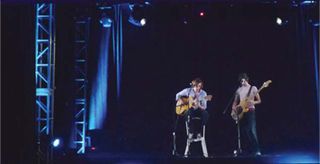3D emerges as a more prevalent technology at InfoComm
3D seemed to be the projection buzz at InfoComm. Granted, there was a lot of activity around new generation, inexpensive, 120 Hz time-sequential 3D compatible projectors that use just one projector, but those were not really staging projectors (they could, however, be useful in many smaller room situations).
But the higher end of 3D with DLP projection was in evidence at InfoComm. A year ago projectiondesign of Norway made headlines with the debut of the F10 AS3D active stereoscopic projector at InfoComm 2008 in Las Vegas, and they were demonstrating the unit this year at InfoComm in Orlando. At the higher brightness, high-resolution end, Digital Projection also had a big presence at InfoComm. DP had five TITAN 3-chip DLP 3D units in action all over the booth, from the 3D theater to the Low Latency pod to the Mechdyne immersive 3D pod (the one where you could look 360 degrees at the motorcycle — very cool). DP also launched TITAN and LIGHTNING WUXGA 3D models (plus other 3D models) at the show as well, so they have a 3D line-up of around 25 distinct displays as of last week.
Christie also had some interesting 3D demos at InfoComm. And a few LCD projector manufacturers had two-projector setups. So, is 3D coming on fast? Will shows you are on feature a bunch of meeting attendees donning funny glasses? The technology is getting much better, and, let’s face it, we could all use something to upsell show producers or end users from plain old IMAG to something that captures some of the pizzazz we first saw with the arrival of widescreen.
Over the next couple of columns, I’ll take you on a whirlwind tour of the arrival of 3D on the staging scene. For the third time. Because, although there’s certainly a lot more punch (and a lot more hype) behind it this time, this is not the first time 3D has “arrived.” And, although 3D hardware and software have changed and matured, the essential way 3D works has not — and that’s what promises to be an exciting new time for staging. In many ways, exciting in the same way as a trip through a minefield would be. Because there’s a lot of fact to separate from fiction in determining your staging choices in the 3D arena, and no single product covers all your bases or options.
For today, let’s separate “3D” from “3D effect” technologies, because both are out there screaming “3D!!” at the top of their mass-marketing lungs, and their costs, potential applications, and usability for any particular purpose are very different. But the basic rules of 3D are easy to understand, because they’re all based on a simple fact. Humans have depth perception because we have two eyes, or binocular vision. Our brain interprets the two flat images created by the eyes into one 3-dimensional picture. There is no real depth perception without two views. This produces the big underlying truth of 3D — there is no way to create a 3D image without being able to present different images to the two eyes of the viewer.
For years, we’ve done this using various types of glasses or filters over the eyes or the displays, and various technologies (such as interlacing with active glasses or polarization of two projectors) to present the images. Although I’ve worked with quite a lot of them, I won’t get into the specific technologies here — it’s just important to remember the basic principle as you look at 3D options: if the system doesn’t provide you control over presenting two different images to the two eyes, it’s a “3D looking” effect rather than being a true 3D, or stereoscopic, system.

Live, interactive 3D holograms were transmitted from London and Montreal to the InfoComm show in Orlando, courtesy of AV Concepts, and Christie.
It’s this simple fact that produces the big separation (pun intended) in 3D products. Stereoscopic systems that provide you eye separation allow for the viewing of truly 3D images that appear to have actual depth. These types of images are created in major productions, industrial design labs, medical facilities, architecture, etc. The production of stereoscopic video requires that the video be shot with two cameras, or with a single stereoscopic camera, or created in a design program that produces true stereoscopic images. The production and display methods used are critical and demanding. However, because of that these types of images are used extensively in high-end applications, both in science and in entertainment.
This produces the second big truth in 3D — there is no way to take existing flat video and make it 3D. If the image didn’t start as 3D, it never will be. Any of the “3D import” or “conversion” processes just add a “3D effect,” which may be momentarily entertaining, but is not useable in critical applications.
These two facts produce the differences in the 3D market — whether a product is usable for actual viewing of a stereoscopic image or is designed to create an eye-catcher. This determines, in turn, whether a 3D system is right for your clients or venues. Both have applications, but they are distinctly different applications.
None of this has changed from the first stereoscopic projection. The critical difference in this new “arrival” is the number of new entries to the equipment market, and their ease of application compared to previous generations. It threatens to make it easier; so more producers will take the plunge that has scared most of them away for many years. For a long time now, 3D has been an application that lots of production companies asked about, but that few actually did when they found out the real processes involved. The new level of integration of these 3D display products may make that better.
So, now that we understand a little about 3D imaging, stay tuned for next issue, where we’ll explore some of the new uses of this generation of 3D.
And, by the way, you’ll need to put on those funny glasses first….
Joel R. Rollins, CTS (joel@rpsystems.net) is a trainer, designer, and author whose career spans all facets of the audio-visual and multimedia industry. Currently a partner in Rollins Performance Systems, Inc., Joel brings the benefit of his experience with a range of noted North American companies, including Riverview Systems Group, Extron, and the ADCOM Presentation Group, to each project. Rollins’s experience also includes 15 years as an instructor at the ICIA Institute for Professional Development.










